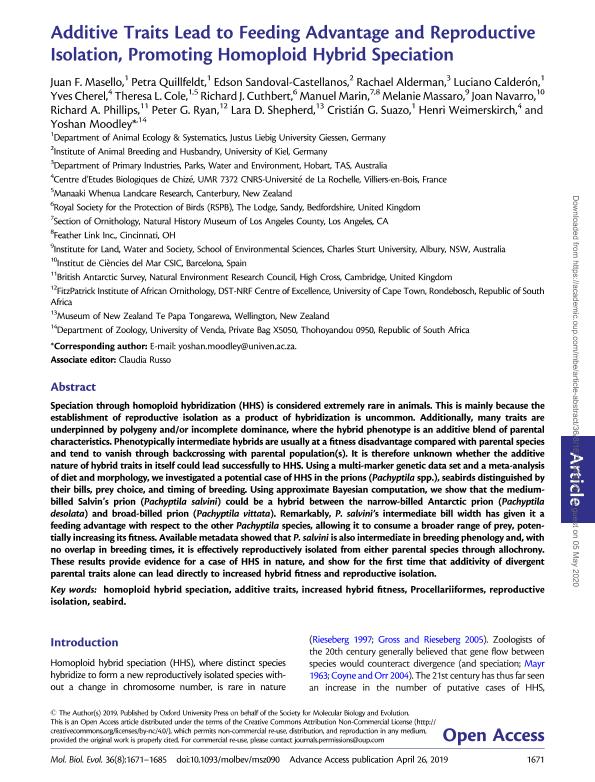Mostrar el registro sencillo del ítem
dc.contributor.author
Masello, Juan F.
dc.contributor.author
Quillfeldt, Petra
dc.contributor.author
Sandoval Castellanos, Edson
dc.contributor.author
Alderman, Rachael
dc.contributor.author
Calderón, Pablo Luciano Sebastian

dc.contributor.author
Cherel, Yves
dc.contributor.author
Cole, Theresa L.
dc.contributor.author
Cuthbert, Richard J.
dc.contributor.author
Marin, Manuel
dc.contributor.author
Massaro, Melanie
dc.contributor.author
Navarro, Joan
dc.contributor.author
Phillips, Richard A.
dc.contributor.author
Ryan, Peter G.
dc.contributor.author
Shepherd, Lara D.
dc.contributor.author
Suazo, Cristián G.
dc.contributor.author
Weimerskirch, Henri
dc.contributor.author
Moodley, Yoshan
dc.date.available
2020-05-12T17:02:58Z
dc.date.issued
2019-04
dc.identifier.citation
Masello, Juan F.; Quillfeldt, Petra; Sandoval Castellanos, Edson; Alderman, Rachael; Calderón, Pablo Luciano Sebastian; et al.; Additive traits lead to feeding advantage and reproductive isolation, promoting homoploid hybrid speciation; Oxford University Press; Molecular Biology and Evolution; 36; 8; 4-2019; 1671-1685
dc.identifier.issn
0737-4038
dc.identifier.uri
http://hdl.handle.net/11336/104889
dc.description.abstract
Speciation through homoploid hybridization (HHS) is considered extremely rare in animals. This is mainly because the establishment of reproductive isolation as a product of hybridization is uncommon. Additionally, many traits are underpinned by polygeny and/or incomplete dominance, where the hybrid phenotype is an additive blend of parental characteristics. Phenotypically intermediate hybrids are usually at a fitness disadvantage compared to parental species and tend to vanish through backcrossing with parental population(s). It is therefore unknown whether the additive nature of hybrid traits in itself could lead successfully to HHS. Using a multi-marker genetic data set and a meta-analysis of diet and morphology, we investigated a potential case of HHS in the prions (Pachyptila spp.), seabirds distinguished by their bills, prey choice and timing of breeding. Using approximate Bayesian computation, we show that the medium-billed Salvin?s prion (P. salvini) could be a hybrid between the narrow-billed Antarctic prion (P. desolata) and broad-billed prion (P. vittata). Remarkably, P. salvini?s intermediate bill width has given it a feeding advantage with respect to the other Pachyptila species, allowing it to consume a broader range of prey, potentially increasing its fitness. Available metadata showed that P. salvini is also intermediate in breeding phenology and, with no overlap in breeding times, it is effectively reproductively isolated from either parental species through allochrony. These results provide evidence for a case of HHS in nature, and show for the first time that additivity of divergent parental traits alone can lead directly to increased hybrid fitness and reproductive isolation.
dc.format
application/pdf
dc.language.iso
eng
dc.publisher
Oxford University Press

dc.rights
info:eu-repo/semantics/openAccess
dc.rights.uri
https://creativecommons.org/licenses/by-nc-sa/2.5/ar/
dc.subject
HOMOPLOID HYBRID SPECIATION
dc.subject
ADDITIVE TRAITS
dc.subject
REPRODUCTIVE ISOLATION
dc.subject
INCREASED HYBRID FITNESS
dc.subject
PROCELLARIIFORMES
dc.subject
SEABIRD
dc.subject.classification
Genética y Herencia

dc.subject.classification
Ciencias Biológicas

dc.subject.classification
CIENCIAS NATURALES Y EXACTAS

dc.subject.classification
Biología

dc.subject.classification
Ciencias Biológicas

dc.subject.classification
CIENCIAS NATURALES Y EXACTAS

dc.subject.classification
Ecología

dc.subject.classification
Ciencias Biológicas

dc.subject.classification
CIENCIAS NATURALES Y EXACTAS

dc.title
Additive traits lead to feeding advantage and reproductive isolation, promoting homoploid hybrid speciation
dc.type
info:eu-repo/semantics/article
dc.type
info:ar-repo/semantics/artículo
dc.type
info:eu-repo/semantics/publishedVersion
dc.date.updated
2020-04-28T14:34:56Z
dc.journal.volume
36
dc.journal.number
8
dc.journal.pagination
1671-1685
dc.journal.pais
Reino Unido

dc.journal.ciudad
Oxford
dc.description.fil
Fil: Masello, Juan F.. Justus Liebig University Giessen; Alemania
dc.description.fil
Fil: Quillfeldt, Petra. Justus Liebig University Giessen; Alemania
dc.description.fil
Fil: Sandoval Castellanos, Edson. Justus Liebig University Giessen; Alemania
dc.description.fil
Fil: Alderman, Rachael. Justus Liebig University Giessen; Alemania
dc.description.fil
Fil: Calderón, Pablo Luciano Sebastian. Consejo Nacional de Investigaciones Científicas y Técnicas. Centro Científico Tecnológico Conicet - Mendoza. Instituto de Biología Agrícola de Mendoza. Universidad Nacional de Cuyo. Facultad de Ciencias Agrarias. Instituto de Biología Agrícola de Mendoza; Argentina. Justus Liebig University Giessen; Alemania
dc.description.fil
Fil: Cherel, Yves. Centre Detudes Biologiques de Chizé; Francia
dc.description.fil
Fil: Cole, Theresa L.. Justus Liebig University Giessen; Alemania
dc.description.fil
Fil: Cuthbert, Richard J.. University Of Leeds; Reino Unido
dc.description.fil
Fil: Marin, Manuel. Justus Liebig University Giessen; Alemania
dc.description.fil
Fil: Massaro, Melanie. Justus Liebig University Giessen; Alemania
dc.description.fil
Fil: Navarro, Joan. Justus Liebig University Giessen; Alemania
dc.description.fil
Fil: Phillips, Richard A.. Justus Liebig University Giessen; Alemania
dc.description.fil
Fil: Ryan, Peter G.. Justus Liebig University Giessen; Alemania
dc.description.fil
Fil: Shepherd, Lara D.. Justus Liebig University Giessen; Alemania
dc.description.fil
Fil: Suazo, Cristián G.. Justus Liebig University Giessen; Alemania
dc.description.fil
Fil: Weimerskirch, Henri. Centre Detudes Biologiques de Chizé; Francia
dc.description.fil
Fil: Moodley, Yoshan. University Of Venda; Sudáfrica
dc.journal.title
Molecular Biology and Evolution

dc.relation.alternativeid
info:eu-repo/semantics/altIdentifier/url/https://academic.oup.com/mbe/advance-article/doi/10.1093/molbev/msz090/5480301
dc.relation.alternativeid
info:eu-repo/semantics/altIdentifier/doi/http://dx.doi.org/10.1093/molbev/msz090
Archivos asociados
